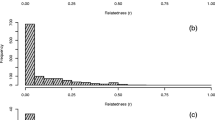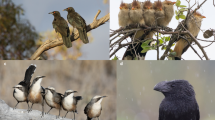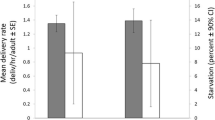Summary
This paper reports on 5 years of observatiors of individually marked saddle-backed tamarins (Saguinus fuscicollis, Callitrichidae). Although callitrichids have long been presumed to have a monogamous social system, this study shows that the breeding structure of saddle-back tamarin groups is highly variable. Groups most commonly include two or more adult males and a single reproductive female, but occasionally contain only a single pair of adults, or less often, two reproductively active females and one or more males. Data on group compositions, group formations, intergroup movements and copulations show that the social and mating systems of this species are more flexible than those of any other non-human primate yet studied. Infants (usually twins) were cared for by all group members. There were two classes of helpers: young, nonreproductive individuals who helped to care for full or half siblings, and cooperatively polyandrous males who cared for infants whom they may have fathered. The observations suggest that non-reproductive helpers may benefit from their helping behavior through a combination of inclusive fitness gains, reciprocal altruism, and the value of gaining experience at parental care.
Similar content being viewed by others
References
Alexander RD, Noonan KM (1979) Concealment of ovulation, parental care, and human social evolution. In: Chagnon NA, Irons W (eds) Evolutionary biology and human social behavior: an anthropological perspective. Duxbury, North Scituate, Mass, pp 436–453
Axelrod R, Hamilton WD (1981) The evolution of cooperation. Science 211:1390–1396
Brand HM, Martin RD (1983) The relationship between female urinary estrogen excretion and mating behavior in cottontopped tamarins, Saguinus oedipus oedipus. Int J Primatol 4:275–290
Brown JL (1978) Avian communal breeding systems. Annu Rev Ecol Syst 9:123–155
Brown K, Mack DS (1978) Food sharing among captive Leontopithecus rosalia. Folia Primatol 29:268–290
Chivers DJ (1974) The siamang in Malaya: A field study of a primate in tropical rain forest. In: Contributions to primatology, vol 4. Karger, Basel
Dawson GA (1978) Composition and stability of social groups of the tamarin, Saguinus oedipus geoffroyi in Panama: ecological and behavioral implications. In: Kleiman DG (ed) The biology and conservation of the Callitrichidae. Smithsonian, Washington, DC, pp 23–28
Eisenberg JF, Muckenhirn NA, Rudran R (1972) The relation between ecology and social structure in primates. Science 176:863–874
Ellefson JO (1974) A natural history of white-handed gibbons in the Malayan peninsula. In: Rumbaugh DM (ed) Gibbon and Siamang, vol 3. Karger, New York, pp 1–136
Emlen ST (1978) The evolution of cooperative breeding in birds. In: Krebs JR, Davies NB (eds) Behavioral ecology: an evolutionary approach. Sinauer, Sunderland, Mass, pp 245–281
Epple G (1972) Social behavior of laboratory groups of S. fuscicollis. In: Bridgewater PD (ed) Saving the lion marmoset. Proceedings of the WAPT Golden Lion Marmoset Conference. WAPT, Oglebay Park, Wheeling, WVa, pp 50–58
Epple G (1975) Parental behavior in Saguinus fuscicollis spp. (Callitrichidae). Folia Primatol 24:221–238
Epple G (1978) Reproductive and social behavior of marmosets with special reference to captive breeding. Primates Med 10:50–62
Faaborg J, Patterson CB (1981) The characteristics and occurrence of cooperative polyandry. Ibis 123:477–484
Faaborg J, DeVies T, Patterson CB, Griffin CR (1980) Preliminary observations on the occurrence and evolution of polyandry in the Galapagos hawk (Buteo galapagoensis). Auk 97:581–590
Garber PA (1980) Locomotor behavior and feeding ecology of the Panamanian tamarin (Saguinus oedipus). Int J Primatol 1:185–201
Gartlan S (1969) Sexual and maternal behavior of the vervet monkey (Cercopithecus aethiops). J Reprod Fertil (Suppl) 6:137–150
Goldstein MC (1971) Stratification, polyandry, and family structure in Central Tibet. Southwest J Anthropol 27:64–74
Hamilton WD (1964) The genetical evolution of social behavior. I, II. J Theor Biol 7:1–52
Hampton JK Jr, Hampton SH (1965) Marmosets (Hapiladae): Breeding seasons, twinning, and sex of offspring. Science 150:915–917
Hearn JP (1978) The encocrinology of reproduction in the common marmoset, Callithrix jacchus. In: Kleiman DG (ed) The biology and conservation of the Callitrichidae. Smithsonian, Washington, DC, pp 163–171
Hershkovitz P (1977) Living new world monkeys (Platyrrhini), vol 1. University of Chicago Press, Chicago, Ill
Hoage RJ (1978) Parental care in Leontopithecus rosalia rosalia: Sex and age differences in carrying behavior and the role of prior experience. In: Kleiman DG (ed) The biology and conservation of the Callitrichidae. Smithsonian, Washington, DC, pp 293–305
Ingram JC (1978) Parent-infant interactions in the common marmoset (Callithrix jacchus). In: Kleiman DG (ed) The biology and conservation of the Callitrichidae. Smithsonian, Washington, DC, pp 281–291
Izawa K (1978) A field study of the ecology and behavior of the blackmantled tamarin (Saguinus nigrocollis). Primates 19:241–274
Kinzey WG, Rosenberger AL, Heisler PS, Prowse DL, Trilling JS (1977) A preliminary field investigation of the yellowhanded titi monkey, Callicebus torquatus torquatus, in northern Peru. Primates 18:159–181
Kleiman DG (1977) Monogamy in mammals. Q Rev Biol 52:39–69
Kleiman DG (1978) Characteristics of reproduction and sociosexual interactions in pairs of lion tamarins (Leontopthecus rosclia) during the reproductive cycle. In: Kleiman DG (ed) The biology and conservation of the Callitrichidae. Smithsonan, Washington, DC, pp 181–190
Lancascer JB (1971) Play mothering: The relationships between juvenile females and young infants among free-ranging vervet monkeys (Cercopithecus aethiops). Folia Primatol 15:161–182
Malcolm JR, Marten K (1982) Natural selection and the communal rearing of pups in African wild dogs (Lycaon pictus). Behav Ecol Sociobiol 10:1–13
Mason WA (1966) Social organization of the South American monkey, Callicebus moloch: A preliminary report. Tulane Stud Zool Bot 13:23–28
Maynard Smith J, Ridpath MG (1972) Wife sharing in the Tasmanian native hen, Tribonyx mortieri: A case of kin selection? Am Nat 106:447–452
Moehlman PD (1979) Jackal helpers and pup survival. Nature 277:382–383
Neyman PF (1978) Aspects of the ecology and social organization of freeranging cotton-top tamarins (Saguinus oedipus) and the conservation status of the species. In: Kleiman DG (ed) The biology and conservation of the Callitrichidae. Smithsonian, Washington, DC
Ramirez MF, Freese CH, Revilla J (1978) Feeding ecology of the pygmy marmoset, Cebuella pygmaea, in northeastern Peru. In: Kleiman DG (ed) The biology and conservation of the Callitrichidae. Smithsonian, Washington, DC, pp 91–104
Rood JP (1978) Dwarf mongoose helpers at the den. Z Tierpsychol 48:277–287
Rylands AB (1981) Preliminary field observations on the marmoset, Callithrix humeralifer intermedius (Hershkovitz, 1977) at Dardanelos, Rio Aripuana, Mato Grosso. Primates 22:46–59
Skutch AF (1961) Helpers among birds. Condor 63:198–226
Soini P (1982) Ecology and population dynamics of the pygmy marmoset, Cebuella pygmaea. Folia Primatol 39:1–21
Stacey PE (1982) Female promiscuity and male reproductive success in social birds and mammals. Am Nat 120:51–64
Terborgh J (1983) Five new world primates. Princeton University Press, Princeton, NJ
Trivers RL (1971) The evolution of reciprocal altruism. Q Rev Biol 46:35–57
West-Eberhard MJ (1975) The evolution of social behavior by kin selection. Q Rev Biol 50:1–33
Wolfe LG, Deinhardt F, Ogden JD, Adams JR, Fisher LE (1975) Reproduction of wild-caught and laboratory-born marmoset species used in biomedical research (Saguinus sp, Callithrix jacchus). Lab Anim Sci 25:802–813
Wright P (1978) Home range, activity pattern, and agonistic encounters of a group of night monkeys (Aotus trivirgatus) in Peru. Folia Primatol 29:43–55
Wright PC (1984) Biparental care in Aotus trivirgatus and Callicebus molach In: Female primates: studies by women primatologists. Liss, New York, pp 59–75
Author information
Authors and Affiliations
Rights and permissions
About this article
Cite this article
Terborgh, J., Goldizen, A.W. On the mating system of the cooperatively breeding saddle-backed tamarin (Saguinus fuscicollis). Behav Ecol Sociobiol 16, 293–299 (1985). https://doi.org/10.1007/BF00295541
Received:
Accepted:
Issue Date:
DOI: https://doi.org/10.1007/BF00295541




